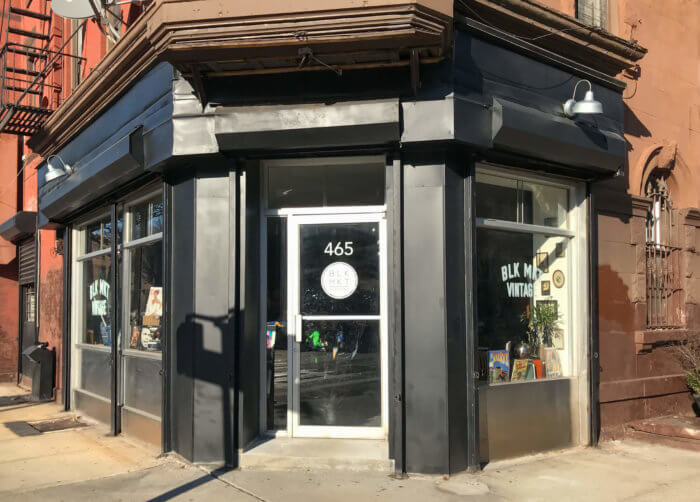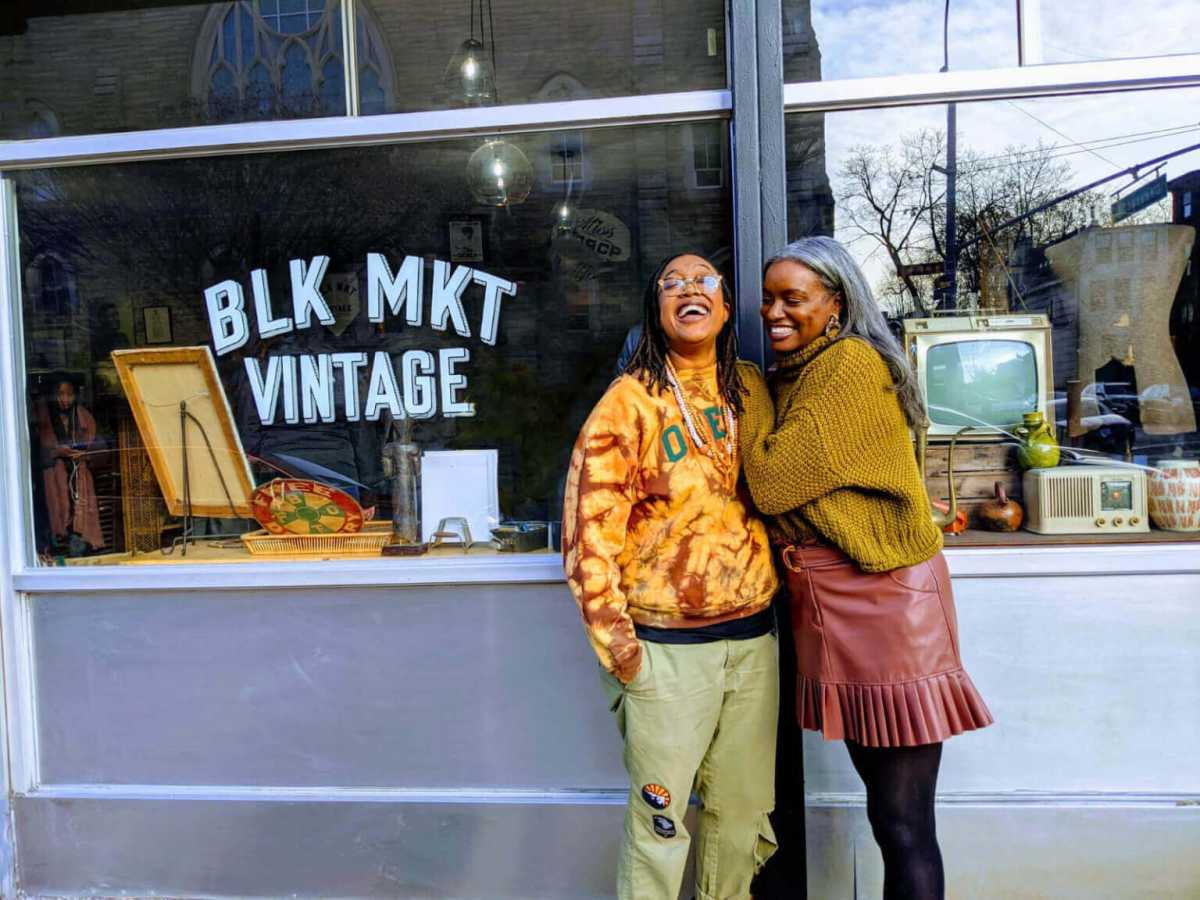By Cate Corcoran
This Black History Month, Brooklynites can head to Bedford-Stuyvesant to check out BLK MKT Vintage — a quaint storefront housing a “collection of Black curiosities, heirlooms, and collectibles,” according to the space’s founders.
Kiyanna Stewart and Jannah Handy founded BLK MKT Vintage after years of selling online and at markets like the Brooklyn Flea, but soon moved into their first brick-and-mortar space in 2019
In a historic building on a busy corner, the vintage seller quickly attracted throngs of enthusiastic locals. They came in to check out antique family photographs displayed in their original frames in the windows, political pins obscure and common from the 1960s and 1970s on counters in the middle of the store, and popular books arrayed in the rear of the space that would have been familiar sights in Black households of decades past, all attractively displayed in an inspiring celebration of Black culture and history.
Handy and Stewart have “rebranded the antique industry” and changed the way we “curate our homes,” according to Refinery29. At the same time, their stores and Instagram have created a community online and in Brooklyn.
Objects for sale have included such treasures as a hardcover edition of “Evidence of Things Not Seen,” signed by the author, James Baldwin, and a vintage pin depicting Malcolm X and bearing the legend “By Any Means Necessary.”
View this post on Instagram
Thanks to the pandemic, the physical store temporarily shut down just a few months after opening. Meanwhile, their Instagram account — including a photo series, “We Been Inside,” that shows historic photos of famous Black people in candid moments — continues to amass an ever growing community of followers who come for the history and culture as much as the shopping.
The couple grew up just a few blocks from each other in East Flatbush and Prospect-Lefferts Gardens but didn’t meet until they were both working at Rutgers University as administrators. Now they live in a townhouse apartment in Jersey City they have artfully filled with collectibles.
In addition to sales, Stewart and Handy also do collaborations, prop rentals and interior design. Recent projects include decorating the Manhattan apartment of friend and sports journalist Taylor Rooks and guest lecturing for a virtual Stanford design course called “Community College: Designing Black and Brown Spaces.”
Why did you want to open a physical store, and how did you pick the Bed-Stuy location?
Stewart: We were founded in 2014 and it was part of our five-year plan to open a physical space, to do justice to the items and give them a context and a home, a physical presence and [create] a flagship for what we do. Community and making people feel seen is a foundational component of the work. We appreciate the way digital space allows us to grow and form a community but nothing compares to [a physical presence].
When will BLK MKT Vintage reopen?
We’re not sure yet. Some things we can’t sanitize in the way we want to and need to because things are sensitive and irreplaceable. It doesn’t feel smart at this moment.
How have your lives changed since opening the store?
Handy: We opened in November, and COVID closed us down four months after opening. We had established regulars, neighbors and folks who would come in. It’s a major milestone for us, it helped us put things in perspective, and also to be grateful we’ve come thus far.
Stewart: A shift we saw was the demand on us to be open at a particular place and time. It forced us to be creative on a regular basis to make time for one another as a couple and for family and friends.
Do you have a favorite item in your home?
Stewart: No. People ask us that all the time. It varies by the month, season, what iteration our home is in. I’m looking at what is around me. And I really love — there are some paintings we sourced from someone who is a collector. He reached out to us because he purchased an entire storage unit. Thousands of items. We ended up buying almost all of it right before our August recess. There is a painting sitting in our bedroom by Clara Jones. It’s really special. That’s my favorite piece right now in this particular room at this moment.
Handy: This is like an I Spy. We have a 1930s Panasonic radio on hairpin legs. The cool thing is it’s one of the first projects we did together. I love when we are able to showcase in our own space an item that has been reimagined.

Tell us a little bit about the photo series you do on Instagram called “We Been Inside.”
Stewart: We were inside. This was at the very start [of the pandemic]. Right when we had closed down the shop. The next week we were thinking what it was going to be like to be indoors indefinitely. We typically show an archival video or photos interspersed throughout offerings on Instagram. It’s nice to provide context, and we come across lots of vintage photographs. It was nice to give it a theme. I didn’t realize we’d still be going at this point. But notable heroes, people we look up to, are regular people and they spend time indoors. To me, it’s impactful to see Muhammad Ali [talking on the phone] or Audre Lorde sitting at her desk writing, or Josephine Baker tending to her garden.
Do you have any advice to others on finding their path?
Stewart: In a lot of ways, I have done what has felt right to me. It sounds wrong when I say it and doesn’t sound like — I have followed my intuition about what felt right to me and matched that with what I needed at that particular moment. There was a time when I didn’t know what my career would look like. I was in a graduate program. [I was asking myself] what are my interests. I felt good when exploring those interests, working with students, working on marginalized communities, queer communities. It was fulfilling even if it wasn’t the salary I wanted. Those are things that can be negotiated — I found a profound sense of joy and fulfillment when doing them.
Handy: I would advise people to choose a path, it doesn’t have to be the right path. Second is knowing when to walk away from certain things. We both were working on a college campus, working as administrators, it was fulfilling and impactful, I felt I could do it forever, but at the end of the day you look in the mirror and you’re not happy doing this work. Am I going to move forward, I don’t feel I am living up to my potential, there’s something else I’m missing. That’s the piece where you’ve got to listen to your gut.
Can you share any tips for displaying art, books, records and other collectibles?
Handy: I’m a fan of the book stack. What are the artifacts you want to preserve and what are the books you want to throw out on the coffee table. You can be creative in where you put them or you can bookend them with a mirror or have some symmetry somewhere. There are so many ways you can use books. They don’t have to live on a bookshelf.
Stewart: Start with the thing that is most interesting to you. So many people have things that have been passed down through the family and they never thought about using them in a decorating way. Lot of people have pictures. Having those photos framed and by a bed or at an end table or table before you leave the house is an easy way to incorporate vintage into your space and in a meaningful way. Even if you’ve got letters, records — you can frame them or put them up on a stand. Start with the things that are meaningful for you.
You also design interiors for clients. How did that evolve?
Stewart: We launched the interiors part of the business two years ago. There was a natural connection between the work we were doing to source objects and putting them in context and think about function at the same time. We have always been sourcing to keep — to keep and to, ultimately, furnish our space or spaces. We launched after some consideration. We have done quite a few projects, mostly home projects. We did a co-working space and home offices. But mostly residential. Mostly people who have a few things and say I don’t know the steps to get it looking like what I want. They don’t know how to get from three pieces of art I have to a place that feels like home to me. They’re all people who identify as Black and all people who are looking for a way to get a space that reflects them. Who these people are is a fundamental part of the process of working with them. It starts with what do you do in the space, how does your space function for you, how do you envision yourself and how do you want your space to serve you? Those projects are fun. Folks now being home are really thinking about I’m here, let me make the investment in making this space work for me.
What are your plans for the future?
Stewart: We have so many. We’re always thinking about what BLK MKT Vintage looks like outside of Brooklyn. Possibly West Coast, Atlanta. Spaces where there is a high population of folks who look like us. More locations, more interior projects, growing our team. We’re interested in projects that can center Black vintage and Black history.
This story first appeared on Brownstoner.com.































